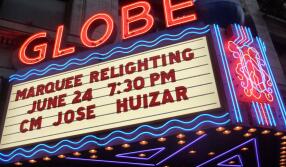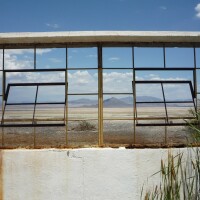
Five Lesser-Known Roadside Attractions Along Route 66
When you think about Route 66, you might imagine the dusty trailways of ghost towns gone by – the diners, gas stations, and other rest stops that were bypassed when new-fangled freeways redirected traffic away from small towns and drivers didn't bother to make the detour to visit them.
And you'd be right about that.
You also might imagine getting your kicks on Route 66 in its heyday – with neon signs that beckon weary travelers to grab a bite to eat or spend the night somewhere unusual that they weren't likely to find anywhere else.
Sadly, a lot of those roadside attractions have faded to oblivion. But Route 66 isn't lost altogether, and it's not just a string of towns that are empty shells of their former selves.
In fact, there's a lot more to do on Route 66 in southern California – be it its current designation as the "National Trails Highway" (where you can even find some signage celebrating the historic route) or one of the defunct pathways of the "Mother Road" – than you might expect.
Despite the fact that Route 66 was officially removed from the U.S. highway system in 1985, here are five great stopovers along its lesser-known urban alignments in its westernmost portion, from the greater Los Angeles area into the Inland Empire.
1. Formosa Café, West Hollywood

As you drive along Santa Monica Boulevard, passing through the western gateway of West Hollywood, there's no mistaking the fact that you’re on Route 66. Unlike Beverly Hills – which seems to ignore if not shun its connection with the Mother Road – West Hollywood has embraced the legacy, not only with historic signage but also restored neon, in a partnership with the Museum of Neon Art. But a little farther down the boulevard, toward the eastern gateway of WeHo, the traces of the historic route begin to wane – and that's where you’ll find one of the best-preserved examples of thematic dining in the L.A. area, the Formosa Café. Located across the street from the movie lot that was, at one time or another, Pickford-Fairbanks Studios, United Artists Studio, or Samuel Goldwyn Studio, the bar and restaurant – with all its Cantonese flair – continuously operated from 1945 to the end of December 2016, when it closed to change ownership (to 1933 Group) and get ready for a historically-sensitive restoration.
Like Route 66 itself, it's always been kind of a bumpy ride for the movie star haunt, which is known for its appearance in the Lana Turner scene in "L.A. Confidential." Various threats of development and demolition over the years have ignited the passions of local preservationists, particularly since the 1990s. And now, the Formosa Cafe is in the running to win preservation funding from the "Vote Your Main Street" competition as part of the National Trust for Historic Preservation's Partners in Preservation program. If awarded to the Formosa, the money will go towards the oldest section of the restaurant – that is, the Pacific Electric Red Car trolley (PE #913, in service from 1902 to 1906). In fact, when it first opened, the Formosa — then known as The Red Post Café — was just that old red streetcar! But don't worry about the rest of the historic character of the beloved Hollywood haunt – all the old memorabilia is still in storage, and the infamous safe in the floor (a reminder of the café’s ties to organized crime) still peeks through the laminate flooring in front of one of the red booths.

2. Historic Broadway Sign District / Broadway Theater and Commercial District, Downtown Los Angeles

Miss all the glowing signage of Route 66 at night? Well, just head to the former terminus of Route 66 (from 1926 to 1936) at 7th and Broadway in Downtown LA, where the marquees and facades of the Los Angeles Theatre, The Theatre at Ace Hotel (formerly the United Artists Theatre), Clifton's, and many other businesses – new and old – are lit up with "liquid fire." Even though headlines and preservationists have been calling it a "dying art" for decades, neon is alive and well in downtown L.A. – and continues to be resuscitated as additional historic theatres in the district get restored and reopened.
Broadway has been home to a number of movie palaces and vaudeville theaters since the 1900s – and this corridor is one of the best examples of commercial architecture in southern California. In fact, all of Broadway – from 1st Street to 12th Street – has been designated as a Historic Sign District, an LA City Council policy that encourages the use and rehabilitation of neon in the area. To fully immerse yourself in the nostalgia that surrounds those colored tubes, visit Grand Central Market, where signing a vendor lease means you have to agree to install a neon sign. Although the building itself dates back to the late 19th century, and the market celebrates its centennial this year, its interior has a decidedly mid-century road trip feel – and with its many food stands and stalls, you can journey from Mexico to Italy and all the way to China without ever leaving Broadway. How's that for a kick?

3. Highland Theatre, Highland Park

It's one thing to visit one of our local historic movie theaters that's only open on occasion, for special occasions, but the Highland Theatre is a fully operational cinema that just happens to have some historic recesses. Though its stage entrances and fire escapes are now barbed, and its 1920s Spanish-style exterior has been modernized with some street art murals, it's a neighborhood gem – right along the former path of Route 66, in the North Figueroa Corridor – that's still showing movies on a daily basis. In the typical fashion of multiplexing, it's been split into three screens – but above dropped ceilings and behind red curtains, you can find signs of when this used to be just one theater, with one stage, one screen, and even a balcony. It's certainly gone through some changes — from vaudeville to vintage with a little porn stint in between – but it's still the last remaining historic theatre in Highland Park.
And when you consider the fact that Figueroa Street (formerly known as Pasadena Avenue) was a portion of Route 66 that actually became a freeway (the Arroyo Seco Parkway, or the 110) in 1940, Highland Park was the first of many communities to be bypassed by a new freeway being built or Route 66 being realigned. In the case of Highland Park, it was both – though the L.A. neighborhood has managed to thrive nevertheless, and even retain some of its roadside charm, thanks to vintage neon signs bring relit (including the Highland Theatre’s rooftop neon) and local landmarks like Chicken Boy.
4. James Turrell Skyspace, Claremont

You might not expect much in the way of roadside amusements on a college campus, but these institutes of higher education — known collectively as The Claremont Colleges — are located along "The Main Street of America," so you can expect something a little different here. Not only can you find spellbinding architecture and fascinating flora here, but you can also pay homage to celebrated light and space artist James Turrell at his own alma mater, Pomona College, by visiting his "Dividing the Light" skyspace.
Installed in 2007, the metal canopy structure in the courtyard of the Pomona College Museum of Art makes the end of day an event: Twenty five minutes before sunset, the colored light turns on and begins to slowly change, at first imperceptibly. And then, sometime after the time of sunset officially passes, the light begins to change color — from fuchsia to blue, purple, pink and orange – and runs for a full hour. Then, it starts up again 100 minutes before sunrise and runs a brief, three-minute light show (called a "chime") every hour on the hour throughout the day. If only we could always get a spectacular show by just staring up at the ceiling! "Dividing the Light" is open to the public and access is free, Saturday through Monday while school is in session and every day during summer break. Not only that, but it's the only such skyspace in Southern California that's available for public viewing, as all others are located in private homes and businesses. And that's certainly enough reason to pull off of Route 66 (a.k.a. Foothill Boulevard in Claremont) and stop awhile.

5. First Original McDonald’s Museum, San Bernardino
The McDonald's in Downey may be the oldest standing of the billion-burger-selling chain — but to trace the founding of this fast food empire, you've got to head to San Bernardino. That's where brothers Dick and Mac McDonald discovered the appeal of "speedy" hamburgers and fries and, in 1948, gave Post-War America what they wanted in the form of a walk-up burger stand, marked by a pair of "golden arches." Although its design became the prototype for all McDonald’s locations to come, this first one at 14th and E wasn't included when the McDonald brothers sold the business to Ray Kroc – a deal that was recently dramatized in the film "The Founder" starring Michael Keaton as Kroc – so, in many ways, it's been wiped from the "official" history of the burger operation.
But of course we southern Californians know better – and that McDonald's started right here and not in Illinois. Though the original building itself was demolished in 1972, the building on the site now (built in 1980) functions both as the headquarters for the Juan Pollo chain and as a free museum devoted to McDonald's ephemera and memorabilia from around the world, much of which has been donated by members of the public (including a lot of kids who've given up their Happy Meal toys). The owner of both Juan Pollo and the museum is Albert Okura, who also bought the entire town of Amboy along Route 66 in 2005. While this McDonald's is located a couple of blocks on the other side of the 215 Freeway from the current designation of Route 66 in San Bernardino, file this under "close enough."
Note: This article has been updated June 29, 2021 to reflect the latest available information.













